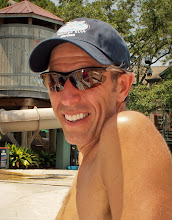Initial impressions of this system are quite good. The camera feels solid in your hands and has just the right amount of "heft" to it without being too heavy. The first thing you want to do it put it up to your eye and start shooting but of course there is no viewfinder, just the three inch screen on back. You've probably read some complaints about the resolution of that screen (it's not quite as crystal clear as the higher res one on my older G10) but I've got no complaints with it. Indoors and in shade it is very usable. Bright sunlight does give problems as it washes out pretty well. You can see good enough to frame your shot but manual focusing is completely out of the question. But as you can see in the shot above of one of the bridges in downtown Cincinnati taken in full sunlight (using the soft focus art filter), good photography is still plenty easy with this camera.
Coming from a Canon background the menus are different but very easy to pick up and I think quite intuitive. I don't like the small selector wheel used for making choices nearly as much as the ones on any of my Canon gear. A bit small and not quite as solid feeling, but again very usable (as it the additional jog wheel towards the top used for additional selections). I don't know if it's just my camera or not but both of my lenses are quite tight going onto and off of the body and occasionally won't seat well enough to make the proper connections even though they appear to be on straight and tight. The optional viewfinder for the 17mm pancake lens is ok and does let you frame the shot by putting the camera to your eye but it's just a simple piece of glass so all you get is the framing. You still have to rely on the camera for good auto focus and have already made your shutter speed, aperture and other selections. I've read some complaints about the option flash gun which is a must as there is no built in flash. First it is absolutely a beautiful accessory for the camera. From a design point it's just stunning. True that it does not tilt or swivel but so far I've only been using it as fill flash and find that it does a terrific job in that category.
To date Olympus has produced two micro four thirds lenses for the Pen, a 17mm pancake prime and a 14-42mm general use zoom. The pancake lens has quickly become my favorite of the two. First it's size is such that the entire camera is almost pocketable and like the flash really makes the camera look stunning. (It's funny, I've never talked about a camera in terms of it's looks or design before but the Pen has changed that.) This is also an f2.8 lens, a stop faster that the variable aperture zoom making it that much better for low light photography and portraits.
The camera has all the modes an advanced enthusiast or pro would expect, plus a few new ones. My favorite new feature not found on any of my other cameras are Olympus' unique art filters. These are basically software manipulations to the image right in camera (and as you're shooting in Live View!) to create different artistic types of creations. Available are Pop Art (vibrant colors and saturation), Soft Focus, Pale Light and Color, Light Tone, Grainy Film (a black and white high grain mode) and Pin Hole which vignettes the image. Reading other takes on the camera it seems like Soft Focus and Grainy Film are the favorites. I would agree. Olympus was really thinking when they implemented the art filters. If you are shooting in Jpeg mode then the filter is immediately applied to the capture and is permanent. (There's also a bit of a delay during writing so don't expect to use these in burst mode.) But if you are shooting RAW, which is recommended for all the obvious reasons, then the Art Filters can be applied after the fact and will be created as a separate Jpeg of the shot with the original RAW file left untouched. Plus this way you can try out a number of different filters on the same image to get a variety of looks.
The final thought on this post is the absolute portability of the entire system. Besides the fact that I have the camera, lenses, etc. all stored in a small PhotoRunner bag, when I went out anywhere that I wanted to take the camera I just grabbed a small North Face waist pack which easily held the camera and both lenses (and on occasion the flash too) with enough room still for a small wallet and cell phone. We took it sea kayaking one morning and everything fit quite well in a small dry bag. The camera is small enough that it was no problem taking it in and out of the bag constantly to get shots on the water without worrying about getting the equipment wet.
So one week of vacation with the new camera and there were only a couple of times when I wished I'd had my full Canon outfit. I would have liked to have my 100mm macro for some flower photography and my 400mm f4.0 prime would have been great for some bird shots, but other than that the tradeoff of traveling with very little gear was a good one.
Enjoy!
Tom Laux
August 22, 2009





No comments:
Post a Comment